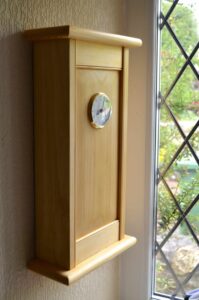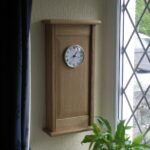Time rests

I think one thing important to knowing your work is to know with equal depth your material. This becomes unnecessary when relying completely on machines to subdue it. My perspectives differ from most and so too those I train in that we see the significance in striving beyond sterile ease to discover the real power possible only though hand tools. Fundamentals undergird our working wood as we twist and turn its substance so repeatedly and then twist and work our tools to task instead of merely shoving wood from end to end into cutter heads and spinning carbide tips and teeth. My perspectives differ further still as I see the need to train early in mastering both the hands and the tools as apposed to machines that substitute for developed skill. It’s then, there, in the quite of our hand work that we discover the true and incredible power of working hand tools.
This clock has many joints and grooves and so too features simply formed beyond the machine that severed the tree from its root and cut and planed the rough-sawn stock to rest upon my bench. From their I reach first for my Disston rip. The teeth cut quick successive strokes and the sides are parted from the waste. Plane work begins to quickly smooth kerf and growth rings never seen before tell tales of many decades gone.
My work rests on my wall and I remember my early years when power woodworking came to me in my chisel’s cutting edge and a plane’s swift unswerving stroke. The lovely softness of shellac now wax-polished in fullness keeps my work for years yet to unfold.



Cool, I’ve been waiting for this one. I’ve always thought that clock behind you on your DVD’s would be a good project to learn. Definitely a great Christmas idea Thanks!
I love it Paul. Just found what I’m making my mother for Christmas!
Paul,
I look forward to this project as well. Looking at the panel got me thinking about the no dumb questions comment you had made earlier. YOu have discussed flattening boards with plane for gluing. I was trying to split out a piece of poplar and create stock from a tree. I noticed I do not have a good idea of how to parallel the second face of a board when it is grossly out. Is it possible for you to comment on this at some time?
Thanks,
Will do. When you say parallel a face, do you mean the boards flatness to the original face is out of parallel as in across the thickness and length of the board?